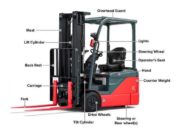Electric forklift control circuit board repair service
Electric forklift control board repair service is one of the important services for businesses using electric forklifts. The control board is one of the most important components of an electric forklift and it ensures safe and efficient operation of the vehicle.
Problems with the control board can be a big hindrance to business operations and need to be fixed quickly. Repair of electric forklift control circuit boards should be carried out by professionals with experience and knowledge of control circuits.
The best electric forklift control board repair services will provide customers with high-quality, fast and cost-effective service. These services provide customers with peace of mind about using electric forklifts after repair and help increase the efficiency of their production operations.
During the repair of the forklift control board, experts will check and identify the problems encountered and make the correct repair to solve the problem. They will also inspect and maintain other forklift components to ensure safety and best performance.
To choose the best electric forklift control board repair service, businesses need to search for information about these service providers in the market and compare the prices and service quality of the services. that case. Businesses also need to consider the reviews and feedback from customers who have used the service before to make the correct decision about the most suitable electric forklift control board repair service.
What are the signs that the electric forklift control board is faulty or damaged?
There are several signs that the forklift control board is faulty or enjoys the following:
– Electric forklifts are not working or are not working properly.
– Operation or warning lights both indicate errors.
– The electric forklift is turned off or automatically turned off.
– The display on the control panel is faulty or incorrect.
– Electric forklifts cannot function properly or do not operate properly when performing operations.
If you experience any of the above signs, businesses need to quickly contact an electric forklift control board repair service to ensure that the operation of the electric forklift is maintained and in the best operation.
What to do when suspecting that the electric forklift control board is damaged?
When suspecting that the forklift control board is damaged, the steps to take are:
Stopping the operation of the electric forklift: Ensure safety and avoid further damage to the equipment.
– Contact the electric forklift control board repair service: Contact a reputable repair service for support and evaluate the condition of the board.
– Use test equipment: If possible, use test equipment such as power meter, multimeter to determine the condition of the board.
– Accept repair: If the condition of the board is determined to be damaged, accept the repair to ensure the operation of the electric forklift.
To ensure the best operation of your electric forklift, businesses need to pay attention to the signs that the board is damaged and contact a repair service quickly.
Where to check and repair electric forklift control board.
Samcovina Joint Stock Company is one of the reputable addresses in the inspection and repair of electric forklift control boards. With a team of professional technicians and complete facilities, Samcovina Joint Stock Company will help businesses quickly and effectively solve problems related to electric forklift control boards. Please contact Samcovina Joint Stock Company for advice and assessment of the control board status of the electric forklift.
Xem thêm về văn bản nguồn nàyNhập văn bản nguồn để có thông tin dịch thuật bổ sung
Gửi ý kiến phản hồi
Bảng điều khiển bên







